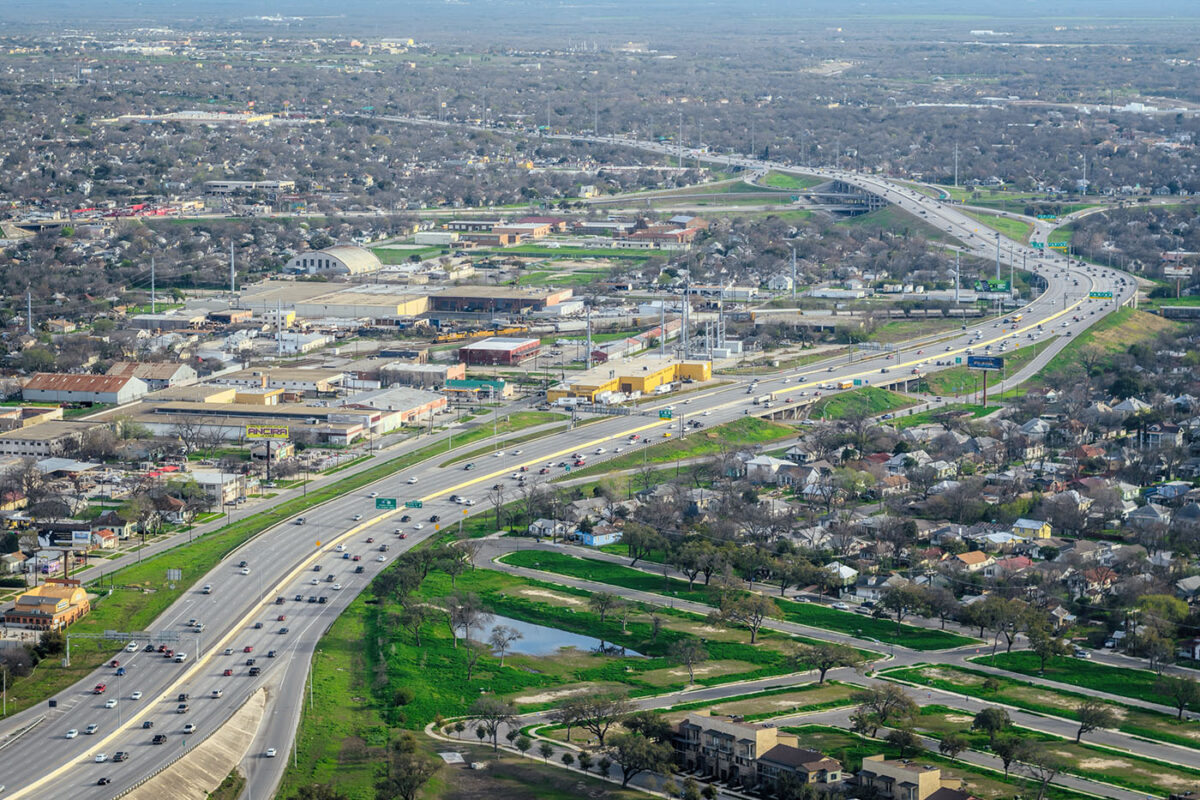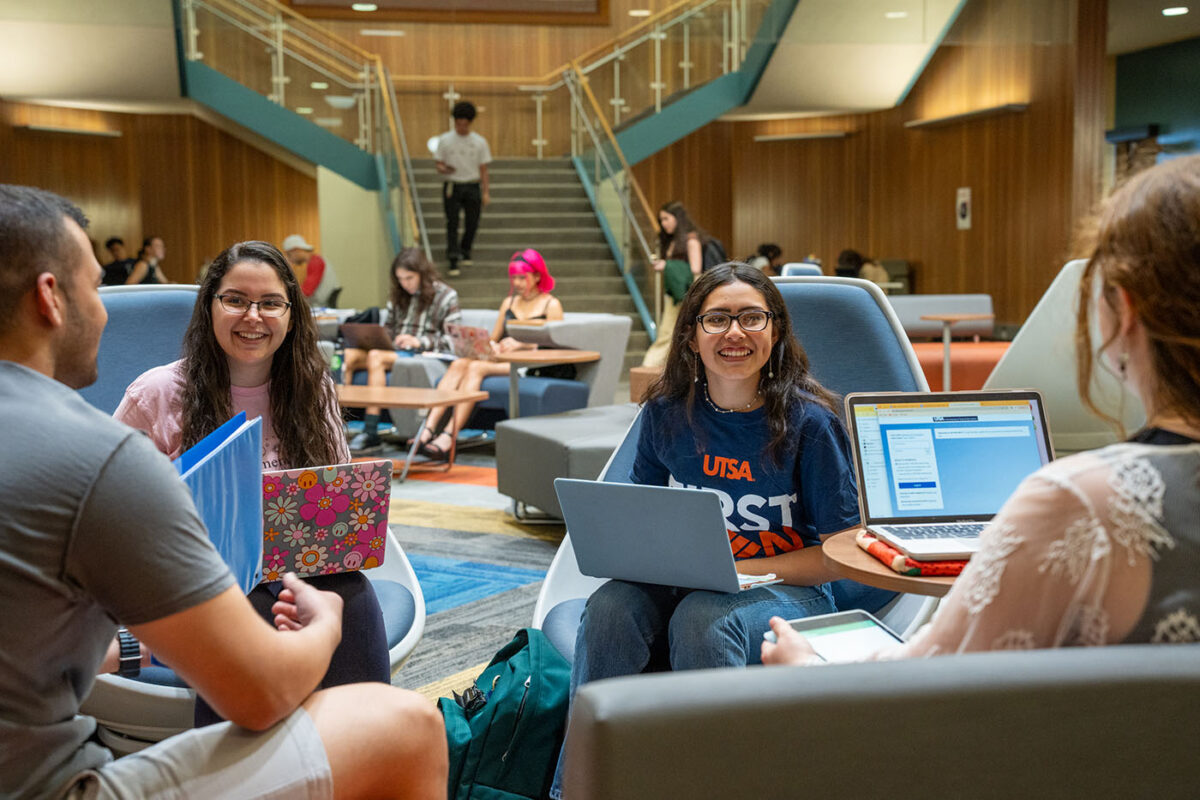San Antonio has emerged as one of the fastest-growing cities in America, but how is that explosion in population growth having an impact on our most pressing public health challenges? Sombrilla Magazine sat down with Lloyd Potter, Texas State Demographer and professor of demography, and Nancy Cheak-Zamora, chair of the Department of Public Health and professor of public health, for a conversation about the intersection of public health and demography as well as how it’s all playing out in the Alamo City.


The most recent U.S. Census Bureau data showed that San Antonio was leading all U.S. cities in population growth. We had 22,000 new residents in 2023. Why are we growing?
Potter: San Antonio historically has been growing pretty steadily for a long time, but it’s been relatively slow. What we’re seeing in the last five to eight years is that the growth in San Antonio has really picked up, and in the last three or four years, we’ve seen that San Antonio is leading the nation in terms of population growth.
There are a number of things that have led to the increase in the pace of growth that we’ve been experiencing. We have growth industries here. Healthcare is certainly a big component of our economy in San Antonio. In addition to civilian healthcare, we have Brooke Army Medical Center and research and treatments that are cutting-edge compared to what’s available nationally or internationally. Of course, UTSA has really accelerated economic development within greater San Antonio — especially in regards to cybersecurity. The university brought CyManII to the city and the NSA now has a major complex at the National Security Collaboration Center. All of those things are attracting a skilled labor force to the city.
But then there’s what we refer to as the multiplier effect. So, you kind of have these core jobs, and then those people that are moving here need a house. That’s going to facilitate the construction industry. They’re going to be buying stuff, whether it’s cars or groceries. That will create other jobs that may be lower-skilled or lower-paid, but still attract individuals to come to San Antonio to find employment.

A lot of the biggest public health challenges in San Antonio are the same as they were a decade ago. Obesity is pervasive. Diabetes and heart disease are affecting some communities much more drastically than others. And San Antonio has historically had low educational attainment and income levels compared to other cities, which have driven down our health outcomes. In recent years, we’ve also seen more focus directed toward domestic violence and mental health. When you talk with your peers in the Department of Public Health, what are they concerned about?
Cheak-Zamora: I just want to say that we are really glad when we’re talking about all of these health disparities and other issues because they’ve always been happening. San Antonio is no different than the nation at large with obesity issues and heart disease being the leading causes of death, but I’m really glad that it’s actually in the conversation now. That helps us all become more aware of it. That helps us think about treatment, so we get people the help and services when and where they need it. That doesn’t happen when no one talks about it or when a topic feels too “taboo” to have a conversation about it. It doesn’t always feel good, but we need to talk about these things to actually improve our overall health.
We concentrate a lot on the social determinants of health in our department, so we’re thinking about all of the things at the same time. Are people able to feel safe in their homes and in their neighborhoods? Are they able to play or exercise around their homes? We think about education, jobs, incomes and how that provides them with the time as well as the resources to make good decisions about their health. We think about food availability. We think about the environment. How’s air quality? How’s pollution? How’s water safety? As you said, we’re trying to manage all of this at once.
We’re doing really well in some areas in San Antonio. Certainly, you know, on the North Side, there are a lot more parks and spaces for the community to do things. The schools are generally better there, so our educational attainment in those areas of San Antonio is fantastic, right? But certainly, on the South Side, we need to invest more there. We need to think more about how we’re providing the basic needs for all San Antonians. We really think about those disparities quite a bit and how — as a university and as a city — we can address the needs of everybody and not just people in certain pockets of San Antonio.

One of the most common public health issues that arises from population growth is water scarcity, and Texas is already staring down a looming water crisis in the 2030s and beyond. How is our community being thoughtful and proactive in addressing that?
Potter: San Antonio Water System has been ahead of the game in terms of ensuring that we have a diversified water supply. If you look at a lot of the other cities on the I-35 corridor, which is kind of the line between surface water areas and ground water areas, most of the other cities along that line don’t have a huge pipeline bringing water from the northeastern part of the state to supplement the sources of water that we’ve already had. I think San Antonio is pretty well-positioned in terms of having a long-term focus on water availability, and again, that’s not true for a lot of other cities in Texas.
Cheak-Zamora: In the ’80s and ’90s, we were getting 100% of our water from the Edwards Aquifer and now it’s only half. San Antonio has had plans to diversify even further for many years. That’s important. As a city, I think we do need to be thoughtful about how we’re utilizing water. Can we change the norms about how we use water outside of our homes — in our gardens, for our grass and for our cars? Across the United States, we may need to rethink where we’re prioritizing water use and make some choices that might feel uncomfortable right now.
In addition to water, a growing population also needs more food. That can be concerning when you think about the challenges we’re already facing here. One in five children in Bexar County are being affected by food insecurity. What are your thoughts on how our region is addressing food insecurity?
Potter: Nancy was talking earlier about the fact that we’re, essentially, a very segregated city. That’s not new. That’s a historic thing. A fair number of people have examined redlining in San Antonio and how that certainly has led to concentrations of Latinos and African-Americans in certain areas of the city. She also mentioned schools and there are some similarities there. While Harris County has one school district, San Antonio has 15 of them and they’re really different in terms of the demographics and the socioeconomic characteristics — the parents, the children and the homes they’re growing up in.
So, the net result of that is there are these concentrations of poverty, which can lead to food insecurity. Certainly, there are food deserts within the greater San Antonio area — where if you wanted to get fresh food, you have to get on a bus or go further away from your home. But, on the other hand, the San Antonio Food Bank is awesome. I mean, it’s very assertive, has raised a lot of money, and has been very effective in terms of distributing food to people who really need it.
Cheak-Zamora: Certainly, the Food Bank is one area of resource for families that are struggling, but we also know that we need SNAP to keep people fed. We need WIC. We need school lunch assistance. We need to keep that in mind in San Antonio as we’re seeing priorities shift at the federal and state level.
As you said, children are the highest number of people that are food insecure in Bexar County, but that’s largely because there are multiple children in most of our families. So, when we see children with food insecurity, that just means that mom or dad are already restricting food intake. The parents are the first ones who stop eating or cutting back on nutrition. When we address food insecurity, we need to think about it as a family issue.

One thing you often see in growing cities are green spaces giving way to new housing developments. But access to green spaces — whether it’s parks, trails or community gardens — is often a top priority for families when choosing where to live and is directly correlated to improved health outcomes. Why are parks and green spaces beneficial for public health? And from a development standpoint, would you say the San Antonio region is adequately prepared for its projected growth?
Cheak-Zamora: Regarding the benefits of green spaces — or even just walking, being out and getting fresh air —we’ve seen medically that it increases serotonin, a chemical that effects our mood and ability to learn. It also decreases things that are associated with heart disease and depression. So, there are physiological benefits to getting outside and being in areas with more trees. It also reduces stress. Social cohesion is important, too. Seeing more people out makes you feel less isolated. These are all benefits of being out in parks or nature in addition to physical exercise.
Potter: I think anything that was designated as a recreational space in San Antonio is probably not getting developed, and the places that are being developed are largely former cow fields or areas that were agricultural. But that said, some of the challenges that are created by developing in those areas is that the infrastructure isn’t always there. We have to make sure we have the capacity for managing sewage, garbage, police, fire and all of those things that go with it.
Transportation infrastructure is something San Antonio is certainly struggling with right now because we didn’t anticipate how much we were going to grow. TxDOT is pouring billions of dollars into San Antonio to develop overpasses and expand some major freeways, and they hold some promise for alleviating some of the congestion that we’ve been experiencing, which certainly impacts our quality of life. But building infrastructure takes a long time. And when you’re growing fast, you’re usually trailing behind the infrastructure demand. It takes a long time to plan and build, so there’s always a lag between when the people show up and infrastructure catches up to meet their needs.
That probably goes for sidewalks as well. Outside of the downtown core, you likely wouldn’t hear from many San Antonio residents who consider this a walkable city.
Potter: I think San Antonio’s been fairly proactive in developing the trail system across the city — in terms of defining the trails, connecting the walkways and so on. That doesn’t mean that we always have adequate opportunities for exercise and outdoor activities, but it certainly has helped dramatically. A lot of that has happened in the north and northwest parts of the city, but we’ve also seen it happen in the south and the east as well. So, you know, we’ve seen the city investing pretty heavily in providing opportunities for people to get outside to walk or ride bikes and get physical activity.
Cheak-Zamora: Ideally, we’d like to see a park within a 10-minute walk from your house. That’s happening in some neighborhoods, but that’s a challenging goal for lots of areas of San Antonio. I also want to note that the lack of sidewalks has been an issue in city satisfaction surveys. I know I see that in my neighborhood. Lloyd, has there been any work to address that?
Potter: Yeah, there are definitely areas where we have walkability challenges because most of the roads were built without sidewalks and, essentially, the city has been trying to retrofit them. There’s still a long way to go there, especially as you get further out. And so, you know, people are walking along the side of the road. We certainly have a big issue with pedestrian fatalities and that takes away a lot of incentive for people to walk in San Antonio because they’re thinking ‘I’m putting my life on the line’ whenever they want to walk somewhere or cross a street.
Cheak-Zamora: Exactly. And that’s tied 100% to obesity, heart disease, depression and cancer risk because we can’t or don’t feel safe getting outside and exercising.

It was widely reported last fall that there’s a 20-year life expectancy gap between some North Side communities and the South Side. But in terms of growth, the North Side is outpacing the South Side, so that part of the city is more likely to get new healthcare facilities and other resources. With that in mind, where is the greater San Antonio area’s population growth high and where is it low? Are some pockets of the region growing more than others?
Potter: As you noted, North San Antonio is growing. But North San Antonio is also getting pretty close to being built out. If you go all the way up to Comal or Kendall counties, there are pretty much houses almost all the way up to the edges of those borders. That means that those areas probably aren’t going to grow much more. Once the land use has been set as residential, commercial or industrial, it tends to not change dramatically. When you look at the North Side, it’s kind of filling up. And the Far West Side is getting there as well, even though that’s where a lot of the growth has been recently. So, what’s happening now is that we’re looking at the urban core. You can’t build housing units there unless you build upward. We’re starting to see that a little bit downtown, but not like what we’re seeing in Austin. I mean, Austin’s like one high-rise condo after another, right? San Antonio’s not there yet — and that kind of housing isn’t accessible to everyone.
So, with all of that said, I think there certainly is increasing interest among developers looking into South San Antonio — especially down near Texas A&M-San Antonio and that whole area around 410. There’s a lot of land there. It’s not too far away from city’s core and there’s a lot of potential there. I think that area hasn’t been growing too much largely because of the social and economic conditions between the downtown core and 410. But once you get outside the 410, there’s really a lot of land out there that can be developed, and a lot of it’s been plotted already and they’re beginning to do development. So, I see that as the area that’s likely to have really accelerated growth.
Has San Antonio’s accelerated growth led to providers who are generally overwhelmed or understaffed? How big a problem is healthcare access in the city?
Cheak-Zamora: I can’t speak to the provider experience as much, but I would say that our “safety net” hospitals and clinics are always under-resourced and over-utilized.
I think a greater concern is that 17% of people in San Antonio are uninsured. That’s almost twice as high as the national rate, which is between 8 and 9% uninsured. That certainly creates significant problems because if people aren’t able to pay for the services, they’re either: 1) not going to visit the doctor; 2) they’ll take on medical debt or; 3) their care becomes a loss to the institution or healthcare center. That’s something huge that we need to be thinking about: how our high uninsured rate is affecting our overall health as well as the safety and security of our healthcare system.

In addition to the general population in San Antonio, the number of children and the elderly who need extra care is also going up significantly. How does that affect day cares, assisted living facilities and nursing homes? And what impact is that having on families who need to find a way to afford that care?
Potter: Yeah, I mean, child care is a challenge given that we have a high rate of poverty in our population. That often means that both parents are working — and working long hours at relatively low-income jobs — which creates a greater need for child care. San Antonio has Head Start programs dispersed pretty well across the city. We also have Pre-K 4 SA, which is not child care per se, but it essentially provides a place where people can send their young children during a big part of the day and they usually provide after-care as well.
Cheak-Zamora: I think day care is a challenge everywhere. It’s so expensive and we have very little support for moms and dads. They generally don’t get enough maternity or family leave, and then many of them are wondering how they’re going to afford child care when they have to go back to work. There isn’t one organization or city or state government that’s going to take care of all of these problems. We all need to work together to get a better understanding and then be creative about solutions.
And when it comes to elderly care, one thing that’s interesting about San Antonio is that we have a lot of multi-generational households compared to other cities. That’s fantastic. We actually know that multi-generational households are better for everybody. It’s often better for kids because they’re experiencing mentorship and seeing firsthand how people live at an older age. It’s much better for seniors because they’re still getting a lot of interaction with their families. That’s good for San Antonio because we’re not overly stressing those facilities. But those families are still under a lot of pressure, so we need to find ways to make sure that the middle generation — the one that is raising the kids and also helping take care of their parents — is also getting support.

Educational attainment and economic stability are social determinants of health in which San Antonio has lagged behind other major cities in the U.S. UTSA has been working hard in recent years to help close that gap — not only to improve social mobility for its graduates, but also to foster workforce and economic development in the region. Are we seeing a significant uptick in education and income in our region?
Potter: Yeah, educational attainment has been going up pretty much for all groups in Texas. I think we can attribute that to our higher ed institutions. You know, Alamo Colleges has done a tremendous job in terms of working with high schools, offering dual credit and trying to facilitate a smoother move from high school into some kind of postsecondary education. UTSA and Texas A&M-San Antonio have great outreach efforts in our local high schools. And both are collaborating with Alamo Colleges on the Promise-to-Promise program. Now, people who might have stopped after getting a two-year associate’s degree are more frequently coming to UTSA to earn a bachelor’s degree. So, I think those efforts are paying off.
You know, we still have a way to go. I’m not trying to say that we’ve solved that problem. But we’ve definitely made tremendous progress in San Antonio from where we were 10 or 15 years ago in terms of advancing educational attainment.
Cheak-Zamora: And I would imagine that what UT System is doing to reduce tuition is going to have some great benefits as well. The new effort to expand Bold Promise to Texas families making $100,000 or less will open up new possibilities to those who never would have thought of going to college because of the potential for incurring debt. That is a win-win for San Antonio and Texas.
One of the things the Department of Public Health is doing, and we’ll need to continue doing, is connecting our students to the workforce. As the chair of a department, I want all of my students to be able to get a job right after they graduate. And we see this time and time again with our students — when they get a job, they’re helping their families and raising them back up. There’s a multi-generation effect. We need to continue to support our students and provide them with workforce resources, so they can continue to have that impact for themselves and their loved ones. Ultimately, good jobs and good incomes are huge drivers of all of the other social determinants of health.



No comment yet, add your voice below!